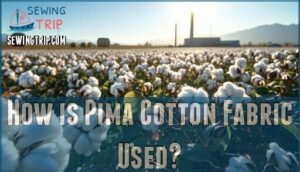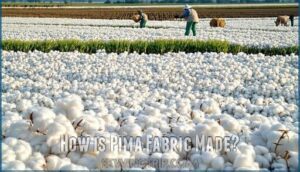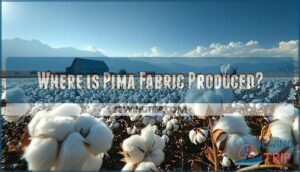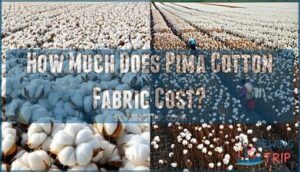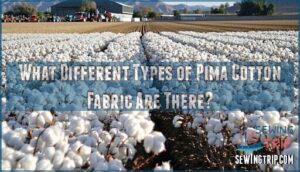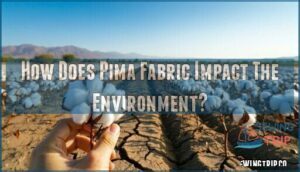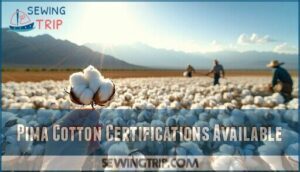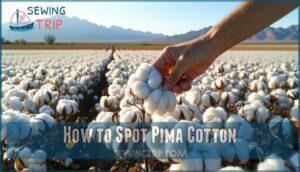This site is supported by our readers. We may earn a commission, at no cost to you, if you purchase through links.
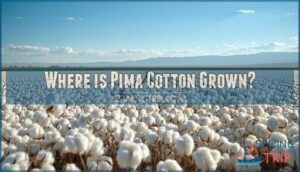 Are you looking to find out where Pima cotton is grown? You’ve come to the right place! In this comprehensive guide, we’ll cover everything there is to know about Pima cotton. From its origins and how it’s used, through different types of production processes and certifications available – all the way down to spotting genuine Pima material.
Are you looking to find out where Pima cotton is grown? You’ve come to the right place! In this comprehensive guide, we’ll cover everything there is to know about Pima cotton. From its origins and how it’s used, through different types of production processes and certifications available – all the way down to spotting genuine Pima material.
We’ll also talk about how much it costs and what impact it can have on our environment when produced without certification standards in mind.
Table Of Contents
- Key Takeaways
- What is Pima Cotton?
- How is Pima Cotton Fabric Used?
- Where is Pima Cotton Grown?
- How is Pima Fabric Made?
- Where is Pima Fabric Produced?
- How Much Does Pima Cotton Fabric Cost?
- What Different Types of Pima Cotton Fabric Are There?
- How Does Pima Fabric Impact the Environment?
- Pima Cotton Certifications Available
- How to Spot Pima Cotton
- Frequently Asked Questions (FAQs)
- Conclusion
Key Takeaways
- Pima cotton is mainly produced in the United States, Australia, and Peru.
- The United States is the birthplace of Pima cotton and has strict quality standards.
- Australia and Peru also produce Pima cotton with sustainable farming methods.
- India is the largest exporter of Pima cotton, but it lacks official origin certification.
What is Pima Cotton?
You’ll love the luxurious feel of Pima cotton, a fabric crafted from extra-long staple (ELS) fibers to provide unparalleled softness and resilience. This unique type of cotton is sourced from the Gossypium barbadense plant, also known as sea island cotton.
It’s distinguished by its distinctive luster and silky texture that won’t pill or fade with washing.
Pima properties are certified by both the American Supima Association (ASA) standards or organic certification processes for quality grading purposes. You can rely on this type of fiber when looking out for your family’s comfort in bedding products.
Though mainly produced in America today, India recently became the largest exporter due to expansive farming practices used there compared to other countries like China, who remains a top contender despite not having any official origin certification yet still providing good quality product overall at competitive prices too.
How is Pima Cotton Fabric Used?
You can enjoy the superior comfort and quality of Pima cotton fabric in high-end clothing, bedsheets, and other linens. It is crafted from extra-long staple (ELS) fibers to provide unparalleled softness that won’t pill or fade with washing.
Pima cotton’s properties are certified by either the American Supima Association (ASA) standards or organic certification processes for excellent results. Machine washing and drying is possible while still maintaining its luxurious feel due to its higher thread counts up to 300—making it more durable than most kinds of cottons used today.
Different types must be considered when shopping around; however, Pima Cotton stands out as one of the best options available in terms of market price versus quality grade consistency – so you can be sure you’re getting exactly what you paid for every time! Plus, if you’re looking for an alternative option, then Supima Cotton verified by The Supima Association might also meet your needs with their crisp cool sheets at slightly higher prices than Egyptian Cotton–which often contains fake fibers grown elsewhere like China or India without third-party monitoring systems in place yet still being sold at premium rates regardless!
Where is Pima Cotton Grown?

Greeting! Pima cotton is a higher-end type of cotton with longer fibers and has become popular in the fashion industry for its luxuriousness. This fabric is grown mainly in three countries: the United States, Australia, and Peru.
United States
The United States is the birthplace of Pima cotton, and its superior properties are certified by the American Supima Association (ASA) for quality assurance. This fabric is crafted from extra-long staple (ELS) fibers and has a distinctive luster and silky texture that can withstand machine washing while still maintaining its luxurious feel due to high thread counts up to 300.
The production process involves handpicking, which reduces environmental impact compared with mechanical harvesting. Water shortages, soil quality, labor costs, pesticide use, and climate change all affect Pima cotton producers in the US.
However, their commitment to producing premium fabrics remains unwavered despite these challenges.
With top-grade Pima cotton fibers derived from Gossypium barbadense plants being grown domestically in America’s southwest regions, it’s no wonder why this fabric remains an enduring favorite among consumers looking for durable yet luxurious clothing or bedsheets!
Australia
Experience the luxury of Pima cotton harvested from Australia. Boasting a long lifespan and superior softness, growers must adhere to strict quality control practices in order for their product to be certified as authentic by the Supima Association.
This ensures that textile industry customers receive only top-grade, luxuriously soft fabrics with consistent quality.
Sustainable farming methods are employed throughout production, reducing environmental impact while also producing premium products sought after by consumers around the world.
Peru
Discover the luxurious softness of Peruvian-grown Pima cotton, grown with sustainable farming methods for a product that’s as strong and comfortable as it is beautiful.
From planting to harvesting, this extra-long staple (ELS) Barbadense Cotton undergoes a rigorous certification process so buyers can be sure they are purchasing only quality fibers.
Learn more about these features:
- Environmental impact: Planting and growing practices reduce environmental impacts while providing premium products to customers worldwide.
- Certification process: All certified Pima cotton meets Supima standards for strength, comfort, color consistency, and durability – ensuring that you get what you pay for!
- Buying guide: Make sure your Egyptian or Pima cotton sheets are genuine by looking out for the Supima’s label when shopping around online or in stores.
- Other varieties: While authentic Peruvian-grown Pima may be hard to find outside of South America, other varieties such as ELS Cotton from China, India, or Australia should also meet high standards if monitored properly! Enjoy superior softness without sacrificing quality today!
How is Pima Fabric Made?
You can feel the luxuriousness of Pima fabric, made from extra-long staple cotton fibers and handpicked for its superior quality. It is highly resistant to pilling and available in thread counts up to 300. This fabric is machine washable, making it an ideal choice for clothing or bedding items that need frequent washing.
Additionally, some Pima cotton may be certified organic or even eco-friendly if production processes are monitored responsibly.
Pima cotton differs slightly from Supima® Cotton, which also comes from ELS (extra-long staple) plants but has a stricter certification process managed by the American Supima Association (ASA). While both types provide great comfort and durability, they differ on the price point, with Pimas being more affordable than Supimas due to their lower standards of quality control when producing overseas markets where labor costs are cheaper.
In terms of environmental impact, there’s not much difference between these two cottons as long as sustainable methods such as crop rotation techniques are used during production, avoiding soil exhaustion while maintaining soil fertility over time.
Also, since most Pima fabrics come pre-washed, there’s no need for harsh chemical treatments that could affect water sources near growing areas, resulting in less harm overall when compared with conventional cottons grown elsewhere around the world today.
Overall, choosing either type will depend upon your needs regarding budget constraints, but rest assured you won’t go wrong investing in either one – whether it’s PIMA or SUPIMA – both offer amazing softness, strength, and extreme longevity thanks to their longer stable fibers!
Where is Pima Fabric Produced?
Explore the luxuriousness of extra-long staple cotton fabrics, made from handpicked high-quality fibers and available in thread counts up to 300, that are produced around the world – from the USA and Peru to Australia and India.
Pima Cotton is one such example which originates from a species of Gossypium barbadense called ELS (Extra Long Staple). It has gained its fame for being ultra-soft yet highly resistant to pilling when compared with other types of cotton.
When it comes down to the production process comparison between different countries, you should be aware that most Pima fabric manufactured overseas may not meet stringent certification processes like those provided by the American Supima Association or Organic certifications – this could affect overall price points as well as environmental sustainability measures taken during production.
So make sure you check your sources carefully before making any purchase decisions.
When comparing prices between different varieties of these soft cottons grown abroad, we can see somewhat similar pricing structures depending on where they’re sourced. However, some regions may offer better value than others due mainly because labor costs vary significantly across locations.
For instance, while Indian markets have recently become the biggest exporters for this type of fabric, their cost structure tends to be lower when compared with US market counterparts due mostly to cheaper labor forces residing there.
Additionally, if you’re looking for an even softer option, then Supima® cotton could also provide great comfort but at a slightly higher cost since it’s been verified through stricter standards set forth by ASA (American Supima Association), ensuring consistent qualities amongst all their products each time!
In the end, whatever choice you decide upon, always remember to identify differences between various options available out there today, verify sources thoroughly, and compare prices accordingly before committing yourself financially towards something you might regret later down the road.
How Much Does Pima Cotton Fabric Cost?
Comparing prices for Pima cotton fabric can be tricky, as the cost varies depending on where it is sourced. For example, while US-grown fabrics tend to come with higher price tags due to stricter quality standards and labor costs, Indian markets may offer a more economical option without sacrificing too much when it comes to overall softness or durability.
The American Supima Association (ASA) verifies high sustainability standards in US-sourced Pima cotton.
Organic certification processes are often available for environmentally conscious shoppers who want assurance of environmental impact reduction from production methods.
India is now the largest exporter of this type of extra long staple (ELS), Gossypium barbadense derived material; however, those products may not have been through third-party certifications like ASA or organic certifiers.
Cheaper alternatives such as Egyptian Cotton could also be considered, but buyers should proceed with caution – 90% of these cottons harvested in Egypt are fraudulent!
Overall purchasing power depends heavily on how informed consumers feel about their choices and what they desire most from their investments – whether that’s luxury comfortability at an affordable price point or assurance that materials were responsibly produced according to certified guidelines before purchase time arrives!
Ultimately though, regardless of whatever preference you go with, there will always remain one constant truth between all varieties here.
What Different Types of Pima Cotton Fabric Are There?
Discover the superior softness and durability of Pima cotton fabric in two main varieties: Supima and Egyptian Cotton.
When comparison shopping for quality fabrics, consumers should first consider sustainable sources to make sure they get the best possible product. Thread counts can give shoppers an idea of comfortability, but a hands-on test is recommended if it’s available.
The higher thread count doesn’t always mean softer fabric – some manufacturers blend short-staple cotton with Pima fibers to cut costs without sacrificing too much on feel or appearance.
Supima Cotton is one variety that has been verified by the American Supima Association (ASA). It is grown mainly in California and Texas, as well as certain tropical islands around South America.
Meanwhile, those looking for something more economical may want to take note when considering Egyptian alternatives. 90% are likely fraudulent, given their origin from countries like China or India instead of actual Egypt itself.
How Does Pima Fabric Impact the Environment?
When it comes to the environmental impact of Pima cotton, there are a few factors to consider. Firstly, organic certification is important for verifying ethical production practices and ensuring sustainable farming methods are used.
Secondly, global trends in environmental degradation due to climate change must also be taken into account when looking at the long-term effects of Pima cotton production.
Thirdly, environmental regulations need to be adhered to by all Supima cotton producers in order for their product not only to meet quality standards but also to lessen its negative effect on the environment as much as possible.
Organic certification helps promote responsible agricultural practices that reduce water consumption and chemical use while preserving soil fertility and biodiversity levels over time. This is especially true with regards to Supima Cotton, which has been verified by the American Supima Association (ASA).
Furthermore, increased demand from emerging markets can lead to greater incentives for environmentally conscious farms if they have proof of organic status.
Additionally, more stringent regulatory frameworks should continue to be implemented worldwide so that local farmers comply accordingly without sacrificing profits or harming ecosystems any further than necessary.
The overall effects vary widely depending on how well each producer follows these rules. However, some may choose less expensive options like bleaching agents, which can produce toxic waste, or non-organic fertilizers containing heavy metals instead.
It’s clear then that consumers need access to information about companies sourcing their materials ethically before making purchases if they really want to make sure their money goes towards helping protect our environment rather than contributing to its destruction through irresponsible buying habits alone.
Pima Cotton Certifications Available
You can ensure you’re getting the highest quality Pima cotton by looking for certifications from reliable organizations like the American Supima Association (ASA). The ASA is an independent organization that verifies and promotes extra-long staple (ELS) cottons, such as Pima and Sea Island varieties.
They also guarantee a minimum thread count of 180, ensuring customers are receiving ultra-soft fabrics with superior durability.
Additionally, they monitor good manufacturing practices to protect their trademarked Supima name in order to uphold its standards of excellence worldwide.
Organic certification is another way to ensure that your purchase meets globally accepted environmental standards for production. Responsible sourcing ensures sustainable farming methods including reduced water consumption and chemical use while preserving soil fertility and biodiversity levels over time when harvesting Pimas or other ELS cottons! This type of verification should be sought out if customers want not only quality but also peace of mind knowing their purchases are not contributing further towards global degradation due to climate change effects already taking place around us today.
Purchasing certified organic products means safer working conditions for employees as well as fewer pollutants released into our air or waterways during processing too! Quality control measures such as checking pilling resistance on all batches before shipping will help bolster consumer confidence in these more expensive yet ultimately worth it investments down the line – especially since many so-called ‘Egyptian’ ones found on market shelves often turn out fake after closer inspection, unfortunately enough, still sadly enough even now.
How to Spot Pima Cotton
Identifying Pima cotton can be difficult, but with a few key steps, you can easily spot the luxurious fabric. To ensure quality assurance and environmental impact are met when purchasing Pima cotton products, look for certified labels such as those from the American Supima Association or organic certifications.
Additionally, familiarize yourself with varieties of ELS cottons such as Sea Island and Pimas.
When looking at materials made of Pima cotton, it is important to note that they should feel softer than regular cotton while being more durable in comparison. This includes items like bedsheets or even a Pima jersey robe! It’s possible that some may contain blends, so it is essential to check fibers carefully before making any purchase decisions.
Furthermore, keep Supima sheets in mind for guaranteed crispness coupled with a cool feeling on the skin during usage. This is due to their high thread count rating (300+). Finally, beware of fake Egyptian Cotton sold under various names.
These might not provide the same level of softness while also having potential risks associated with their unknown origin. They are usually found across Chinese/Indian markets, especially nowadays given current market trends unfortunately enough still today.
Frequently Asked Questions (FAQs)
What is the difference between Pima and Supima cotton?
You may have heard of Pima and Supima cotton, but do you know the difference? Both are ultra-soft fabrics made from extra-long staple (ELS) cotton. However, while Pima is derived from Gossypium barbadense plants grown in various parts of the world, Supima is only sourced in America and certified by a special association.
How do I know if the Pima cotton I’m buying is genuine?
To ensure genuine Pima cotton, look for certification from the American Supima Association or organic labeling. Check its origin and thread count to verify quality. Utilize your experience and knowledge to evaluate the fabric’s softness, durability, and resistance to pilling; these features are unique markers of authentic Pima cotton.
What is the difference between Pima and Egyptian cotton?
Pima cotton is ultra-soft and derived from the Gossypium barbadense plant, while Egyptian cotton is known for its softness and durability. However, 90% of Egyptian cotton in the market can be fake or blended with cheaper fabrics.
Pima may also be blended with other materials, but it is often verified by third parties for quality assurance.
Is Pima cotton organic?
Pima cotton isn’t always organic, but it can be certified by the American Supima Association or as an organic product. Look for a reputable label to ensure you’re getting quality Pima with minimal environmental impact.
What is the life expectancy of Pima cotton?
Pima cotton boasts an impressive life expectancy of up to 50% longer than other cottons. Crafted from the finest fibers and handpicked with care, its ultra-soft feel is unparalleled.
Conclusion
Pima cotton is an incredibly soft and luxurious fabric that has many benefits to offer. It’s resistant to pilling and long-lasting, making it a great choice for those looking for quality fabrics. It’s also an environmentally conscious choice, as it’s handpicked and certified by organizations such as the Supima Association.
With its silky smooth texture and bright, vibrant colors, it’s no wonder that Pima cotton is a popular choice for high-end clothing and bedding. Its beauty is unmatched, like a ray of sunshine in a dark room. Investing in Pima cotton is sure to provide you with years of luxurious comfort.

